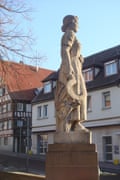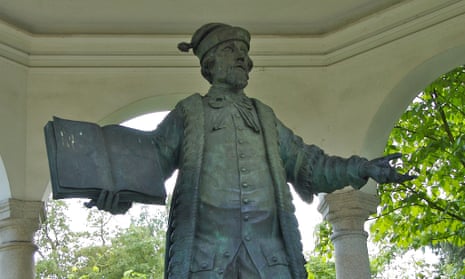Chained to the floor of her prison cell for 14 months while the threat of torture hung over her, the six-year ordeal faced by the elderly mother of the astronomer Johannes Kepler after she was put on trial for being a witch has been pieced together by a Cambridge professor.
Ulinka Rublack, professor of early modern history and a fellow of St John’s College, Cambridge, worked through piles of documents in Stuttgart about the case of Katharina Kepler, and how her famous son abandoned his work in 1620 to help her. The result is The Astronomer And The Witch, out on Thursday from Oxford University Press, and described as the first attempt to provide a full account of Katharina Kepler’s case.
“Usually, when we try to find out about historical witchcraft trials there is limited evidence available,” said Rublack. “In this case, it was possible to reconstruct the whole story. That means we can use Katharina’s case to explore the often overlooked question of how these trials affected individuals and families in sharp focus and harrowing detail.”

Caught up in the witch hunt which swept Europe in the 16th and 17th centuries – around 50,000 people are estimated to have been executed as witches between 1500 and 1700 – the widowed Katharina Kepler was first accused by neighbours in her home town of Leonberg in 1615, when she was 68. Rublack writes that Ursula Reinbold, the wife of a glazier who suffered from a chronic illness, accused Kepler of poisoning her; a 12-year-old girl later said that Kepler had hit her arm when passing by, causing pain which increased until the girl was unable to move a finger.
She was also accused, variously, of killing local animals and turning herself into a cat. Her case would last for six years, the last 14 months of which saw her attached with an iron chain to the floor of a prison cell. “She was subjected to the threat of torture,” said Rublack. “She would have been shown the instruments of torture – they would screw thumbs with heavy irons, and sometimes the thumb would come completely off, causing excruciating pain. They would pull people up on a rack into the air. And she would be talked to in very threatening terms, all the time with a clear agenda to get her to confess.”
In 1620, Kepler, the famed astronomer, astrologer and mathematician who discovered that planets move in ellipses, and defined the three laws of planetary motion, moved his family from Linz to southern Germany to lead his mother’s defence. “He takes up the challenge and takes over the trial – he completely changes his life, packs up his own family,” said Rublack, who describes his defence in her book as a “rhetorical masterpiece” which explained away magical illnesses through knowledge of medicine and common sense.

“He was very good at spotting inconsistencies, and at dissecting in a very scientific way the accusations,” Rublack said. “So he mounted this very pioneering defence.”
Kepler’s mother was set free in the autumn of 1621, but died just six months after the trial’s close. Rublack said that until now, what exists in English language literature – both biography and fiction – about Katharina Kepler gives the impression that she was, indeed, “witchlike”, which “seems to me clearly wrong”.
After going through “two huge bundles with all the documentation” about her case, she “found a much more normal picture”, Rublack said. “When you go through everything, there is nothing which suggests she was someone who was witchlike,” she said.
Her book, she said, is an attempt to address this, as well as to show “what it was like for a family to live through” the six-year trial.
“Johannes Kepler and his mother lived through one of the most epic tragedies in the age of the witch-craze, yet they kept their spirit,” she added. “It is high time to re-evaluate the way in which they have both been portrayed.”
